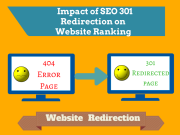What are Referring Domains And It's Impact On SEO?
Referring Domains And It's Impact On SEO
Referring domains indicate the quality of a website, which can impact its SEO. If you want to improve your SEO, focus on obtaining high-quality backlinks from authoritative websites Referring domains is one of the best ways to do this. Referring domains refer to the other websites that link to your website and contain backlinks.
A domain checker tool can help you analyze websites and link how many domains are referring back to yours. This will help you discover potential opportunities and acquire backlinks from entirely new sources, which can give your site’s rankings a boost.
Referring domains are a fundamental aspect of SEO, as they impact a website's authority, credibility, and search rankings. This post will explore the definition of referring domains, their calculation, and their effect on SEO. Additionally, we will discuss the significance of building a diverse and high-quality backlink profile to enhance your website's visibility and organic traffic.
What Are Referring Domains?
Referring domains are external websites that link back to your website because it is essential for SEO since they allow search engines to know that the content is valuable. The more high-quality and diverse referring domains a website has, the higher its authority and visibility in search results. Building a strong and diverse backlink profile is a key component of any successful SEO strategy.

Boost Your Website Authority with Quality Referring Domains for Successful SEO
Strengthening your website authority by having a high number of high-quality referring domains is key to a successful SEO campaign. This can be achieved by receiving backlinks from websites with high domain authority in your niche, such as organic dog food. Having a wide range of sources that link to your website, search engines like Google are more likely to see and rank your website higher than other websites in the organic dog food niche.
Having a lot of quality referring domains also allows search engine rankings to increase as it shows that you are being trusted and received by other sites, thus increasing trustworthiness.
Boosting Website Credibility and Visibility with Referring Domains
Referring domains linking to your website can increase visits, show trustworthiness, improve search engine rankings, and make it easier for consumers to find your website.
Internal links from your website can also boost links from other pages, showing users that quality content is present throughout your entire website. Quality referring domains add credibility to a given link and encourage users to visit the link when they are on other sites or searching through search engines.
Maximizing Your SEO Performance with Referring Domains: Analyzing Backlinks and Quality for Better Rankings
Referring domains are a key factor in SEO and can have a large impact on how well your website’s backlinks perform. In general, referring domains are sites that link to your website. To check the quality of these backlinks, you can use a top linking sites panel to see different domains which link to your site. You can also check new backlinks and see what anchor text is used in each referring domain.
This allows you to see the data associated with each referral domain and determine if it is beneficial for SEO purposes or not. Once you have identified the referring domains, it is important to scroll down the page to view other pages that are linked from those domains including a number of internal pages on each domain.
Maximizing SEO Impact: The Role of Referring Domains and Google Search Console
It is important to link your website, mention your website name, and link how many domains have been created, as this will give you an idea of the level of impact that these referring domains have to SEO. Google Search Console is a tool that gives domain information including receiving how many backlinks, indexed pages, and more. Using the search console you can view the particular referring domain and many target pages on your site. The overview page in the search console will show you a general overview page with details of the total number of links coming in from each referring domain.
Maximizing Your SEO: Evaluating Referring Website Domain, Linking Domain, and Linking Context
Consider the referring website domain and the linking domain. Check if the posted backlink is good for SEO by evaluating its website domain authority, relevance, and source quality.
Evaluated backlinks will help you to determine whether they are beneficial for your SEO efforts & Linking context includes page context, link location, context relevance, and link to the content.
Evaluate site diversity by considering these factors: The number of links from each domain in different locations on different pages; link considerations; the context of the linked page; and context relevance to the content of that page. All these factors have a significant impact on SEO when it comes to evaluating and determining which websites are linking to yours.
Having authoritative websites, or high domain authority websites, link to your website is a great way to improve SEO rankings. This is because Google considers content from websites that have a higher regard and gives more weight to those links when determining how it should rank your site. It is essential to obtain high-quality backlinks from reliable websites because they will improve your site's rating in Google's views.
Boosting Your Website's Traffic and SEO through Link Building with Respected Domains
Increasing backlinks to your content can boost website traffic and SEO. So one of the key focuses of your link-building campaign should be obtaining new backlinks from respected domains in your industry or niche.
Amazing content links from authoritative websites will help you obtain high-quality links which are crucial for success in the online world and also It is important to include new sources and domains within your link-building strategy, as content grows over time and this can help build up a strong acquisition of backlinks.
This means having links to your website from other popular websites could potentially increase your rankings in search engine results, which will in turn lead to more organic search traffic and engagement with potential sales. With zero organic search traffic, it’s difficult for websites to receive as much traffic as possible.
Maximizing Your Referring Domains: Strategies to Boost Your Backlinks and SEO
Referring domains are the websites that link to your website, so utilizing other websites and their blog posts to include a link back to your website can help build more backlinks, as well as build up a huge user base. Having more backlinks from different sources it will generate traffic to your website which in turn leads to better SEO rankings.
Guest posting is another way of increasing referring domains and can offer various benefits such as increased traffic, more exposure for your content, and more social signals for SEO. Additionally including an author bio with a link back to your website at the end of the post will help increase linking opportunities from different websites which can lead to more traffic or even brand recognition if they recognize your author name or profile picture.
In most basic terms, a referring domain is any website that links back to yours, this can be a single backlink from a reputable domain or multiple backlinks from authoritative websites. Google has determined that receiving multiple backlinks from different sources is one of the most important ranking factors.
Boosting Your SEO through Referring Domains: Analyzing Competitors' Backlink Profiles
Analyzing your competitor’s backlink profiles is one of the best ways to get an idea of how to boost your SEO, and this will also help you analyze entire sites and identify referring domains, as well as backlinks from other sites.
By using this data, SEO owners, agencies, and audiences can then analyze their competitors’ backlinks and optimize their own page by identifying referring domains that could benefit the entire site's SEO. To find out which sites are linking to your page, a backlink lookup or search engine should be used.
Building a Strong Link Profile: How Collaborating with Referring Domains Boosts Your SEO?
- Collaborating with your referring domains is essentially important to SEO.
- Locate possible backlink sources such as directories, other websites, social media platforms, forums, and online directories.
- Gain more links from the most relevant sites to your target pages.
- Consider the referring pages and whether they are reputable news sites or blogs when looking for the best-referring sites.
- Include a variety of different referring domains in your link profile to boost its relevance and strength.
- Competitions are another way to expand your link profile; these can be found on online directories or through guest posting opportunities.
- Research the best-referring domains and utilize them in a network of links to your target pages.
- Increase visibility on search engines and build authority for your website.
Examples of Referring Domains and Backlinks
Here are a few examples of referring domains and backlinks:
- A food blogger writes an article about healthy meal prep and links to a recipe on your website for a healthy meal prep dish. The food blogger's website is a referring domain and the link back to your website is a backlink.
- A journalist writes an article about the benefits of yoga and includes a quote from your yoga studio. The journalist's website is a referring domain and the mention of your yoga studio with a link to your website is a backlink.
- A business owner adds a link to your website in their "recommended resources" section on their own website. The business owner's website is a referring domain and the link back to your website is a backlink.
- An online directory includes a link to your website in its list of recommended businesses in a certain category. The online directory is a referring domain and the link back to your website is a backlink.
- An influencer sharing a post about your product on social media with a link to your website is an example of a backlink from a referring domain.
- A forum member includes a link to your website in a post discussing a topic related to your industry. The forum website is a referring domain and the link back to your website is a backlink.
- A guest post you wrote for another website includes a link back to your website in the author bio or within the content. The website you wrote for is a referring domain and the link back to your website is a backlink.
- A news website publishes an article about a topic related to your industry and links to your website as a source of information. The news website is a referring domain and the link back to your website is a backlink.
These are just a few examples, but any time another website links back to your website, it is considered a backlink from a referring domain.
Explanation of how to identify high-quality Referring Domains for link-building purposes?
Identifying high-quality referring domains is essential for creating a strong and diverse backlink profile. Here are a few ways to identify high-quality referring domains for link-building purposes:
1. Domain authority: Check the domain authority of the referring domain using tools such as Moz, Ahrefs, or SEMrush. A high domain authority indicates that the website has a strong and reputable online presence.
2. Relevance: Check if the referring domain is relevant to your website's niche or industry. Backlinks from relevant websites are more valuable and can help improve your website's visibility in search results.
3. Traffic: Check the referring domain's traffic using tools such as SimilarWeb or Alexa. A website with high traffic indicates that it has a large audience and can potentially drive more traffic to your website.
4. Backlink profile: Check the referring domain's own backlink profile to ensure that it has a strong and diverse backlink profile. If the website has low-quality or spammy backlinks, it may negatively impact your website's SEO.
5. Social media presence: To maximize the impact of referring domains on your website traffic, consider the social media presence of these domains. A strong social media presence can indicate an engaged audience that is more likely to share and promote your content, driving additional traffic to your website.
6. Trustworthiness: You can evaluate the credibility of the referring domain by examining elements like website design, content quality, and editorial standards. A reliable website is more likely to create top-notch content and link back to authoritative sources.
7. Link placement: When analyzing a referring domain, it is important to consider where the backlink is located. Backlinks included within an article or blog post's main body hold greater value than those located in a website's footer or sidebar. This is because backlinks within the main content are more likely to be seen and clicked by users, which can lead to more traffic and improved SEO.
In summary, when identifying high-quality referring domains for link-building purposes, consider factors such as domain authority, relevance, traffic, backlink profile, social media presence, trustworthiness, and link placement. By focusing on these factors, you can build a strong and diverse backlink profile that can improve your website's visibility and ranking in search results.
Conclusion
Referring domains impact SEO by providing backlinks to a website. High-quality domains with high authority, relevance, traffic, trustworthiness, and proper link placement can improve SEO, but Low-quality domains can harm SEO. Building a diverse backlink profile with high-quality domains is important for SEO success.
Having a diverse and relevant mix of high-quality referring domains is important for SEO success. It is also crucial to regularly monitor and analyze backlinks, disavowing any low-quality or spammy domains that may harm your SEO.





